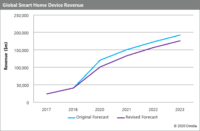According to global tech market advisory firm ABI Research, the COVID-19 pandemic is expected to cause a significant pushback on biometric device shipments, creating a major revenue drop of $2 billion over the course of 2020. At the same time, the pandemic has given rise to new identification and surveillance needs, spurring further investments in biometric AI algorithm design, which will give a boost to the face recognition technologies market going forward.
“Contact biometric technologies like fingerprint and vein have been dealt a substantial blow due to new governmental regulations targeting contact and close-proximity interactions,” said Dimitrios Pavlakis, digital security analyst, ABI Research. “Fingerprint biometrics vendors are struggling to uphold the new stringent hygiene and infectious control protocols. These regulations have been correctly introduced for the safety of users and personnel, but they have also affected sales in certain verticals . . . On-premise physical access control, user registration, identification and workforce management systems have been greatly affected in the enterprise and commercial space, but these applications also spread into healthcare, law enforcement, border control, government, civil and welfare."
While contact-only companies will have additional hurdles to overcome in most markets, innovative companies like Gemalto and IDEMIA have already adapted their solutions offering contact-less fingerprint sensing technologies. Additionally, fingerprint sensor vendors operating in consumer markets like FPC and Goodix will be mostly affected by smartphone sales, rather than hygiene concerns, due to the personal nature of user authentication.
The total biometric device market is expected to reach $28.2 billion in 2020, with the government and security market taking a significant hit of $1.1 billion. Fingerprint device sales are also expected to decrease in 2020 by $1.2 billion. Not all is bleak, however.
“AI biometric firms are adapting to the biological threat,” Pavlakis said. “Biometric technologies are currently undergoing a forced evolution rather than an organic one, with artificial intelligence biometric firms spearheading the charge. New IoT and smart city-focused applications will enable new data streams and analytics, monitoring infection rates in real-time, forcing new data-sharing initiatives and even applying behavioral AI models to predict future outbreaks.”
Face and iris recognition have been brought into the spotlight as key technologies allowing authentication, identification and surveillance operations for users and citizens wearing protective headgear, face masks or, those with partially covered faces. These elements that were the bane of face recognition algorithms in the past have now been integrated into algorithm developers’ value proposition followed by a further investment boost targeted at surveillance, video analytics and smart city applications. Temperature and fever detection technologies making use of infrared technologies have also been retrofitted in access and border control while biometric telemedicine applications are providing healthcare support to consumers and patients remotely.
These findings are from ABI Research’s “Assessing the Impact of COVID-19 on the Biometrics Market” application analysis report. This report is part of the company’s digital security research service, which includes research, data and ABI Insights.



